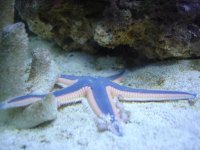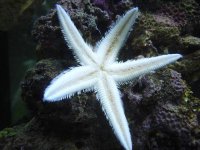So I was combing the beach today and found nothing. So being the curious Christian I am I was like, dear God I drove all this way and found diddly squat, could you uh....help out. Then I looked further and 30 feet from my car found not one but two of these sweet starfish sitting out of the tide pool drying out. I put them in my tank and they are quite happy. Any ideas what they are?
You are using an out of date browser. It may not display this or other websites correctly.
You should upgrade or use an alternative browser.
You should upgrade or use an alternative browser.
Rescued Seastars (ID needed)
- Thread starter blackcloudmedia
- Start date
Phataria unifascialis (Gray 1840), the Blue Sea Star. Family Ophidiasteridae. To 7 inches in diameter. Eastern Pacific; Sea of Cortez to Peru and the Galapagos, rocky shores to 50 meters depth. Dorsal surface blue or tan with black pebbled lines, underside orange. Algae feeder.
It looks the same but I trust David's ID more than mine.
It looks the same but I trust David's ID more than mine.
In other words, will starve in aquarium soon?!davidmohr":1vaofc5j said:It is a carniverous burrowing sea star, it feeds on small crustaceans, molluscs and urchins.
PitPat":3kt1scq4 said:If you collected this on the beach in Florida it seems unlikely that it is a starfish found in the eastern Pacific.
But I don't know what it is.
Thank you
bleedingthought":2c3jnwit said:In other words, will starve in aquarium soon?!davidmohr":2c3jnwit said:It is a carniverous burrowing sea star, it feeds on small crustaceans, molluscs and urchins.
That's pretty much the gist of it, yes. Unfortunately now that they have likely been exposed to stuff from the Indo-Pac (unless the tank was stocked exclusively with Caribbean rock and animals) it would be irresponsible to place them back in the wild.
Matt_Wandell":1l8w8x14 said:bleedingthought":1l8w8x14 said:In other words, will starve in aquarium soon?!davidmohr":1l8w8x14 said:It is a carniverous burrowing sea star, it feeds on small crustaceans, molluscs and urchins.
That's pretty much the gist of it, yes. Unfortunately now that they have likely been exposed to stuff from the Indo-Pac (unless the tank was stocked exclusively with Caribbean rock and animals) it would be irresponsible to place them back in the wild.
Why though? Because the get a taste of the Caribbean?
Possibility of contamination, spreading of foreign parasites, etc. Kind of like when the native americans got sick from the british and then went back to their tribes, bringing with them new diseases that their immune systems were not prepared for therefore causing them to die.wings":2rmc7pxq said:Matt_Wandell":2rmc7pxq said:bleedingthought":2rmc7pxq said:In other words, will starve in aquarium soon?!davidmohr":2rmc7pxq said:It is a carniverous burrowing sea star, it feeds on small crustaceans, molluscs and urchins.
That's pretty much the gist of it, yes. Unfortunately now that they have likely been exposed to stuff from the Indo-Pac (unless the tank was stocked exclusively with Caribbean rock and animals) it would be irresponsible to place them back in the wild.
Why though? Because the get a taste of the Caribbean?
Somewhat of a poor analogy but at least that's the way I see it!
Hmm I see but luckily for me I have a 29 gallon that is filled with hermits, crabs, and all the hitchhiker rejects that I recieved in my rock....I have lots..I also have TONS of Coquina clams that I collected from the beach, a sand bed full of these guys does wonders on water quality. The only difference between my 55 gal and my 29 gal is the coquina clams and there is a remarkable difference in the sand color and algae content. Anyways these stars being from the atlantic will be quite happy with the coquinas considering they are from the same region.
blackcloudmedia":2ma0eg9z said:Hmm I see but luckily for me I have a 29 gallon that is filled with hermits, crabs, and all the hitchhiker rejects that I recieved in my rock....I have lots..I also have TONS of Coquina clams that I collected from the beach, a sand bed full of these guys does wonders on water quality. The only difference between my 55 gal and my 29 gal is the coquina clams and there is a remarkable difference in the sand color and algae content. Anyways these stars being from the atlantic will be quite happy with the coquinas considering they are from the same region.
Did you read this?
Biogeek":2ma0eg9z said:We have large shallow holding tanks (~10 ft by 2.5 ft) here at UC Davis that we use for invertebrate labs, and I had a couple of them set up with nice sandbeds of local animals to use for display in the labs. The addition of a few Astropecten to that large bed eliminated all visible life (including snails, worms, clams, heart urchins, and sea pansies) from the sandbed in only a couple of weeks...
Kinda makes you wonder how long it will take to make a serious dent in the sandbed population of your 45 gallon tank, doesn't it?
wings":1z8023gd said:Matt, why can't you return it to the ocean?
Well I'm sure one could return it to the ocean and it would be fine. It just seems irresponsible to me, for the reasons bleedingthought mentioned.
There could be a larva of a Pacific red bug that decimates A. palmata on the starfish when it goes back in. There could be a larva of some weird flatworm, starfish, worm, crab, etc. that isn't found in the Caribbean and eats, I don't know, royal grammas or something.








